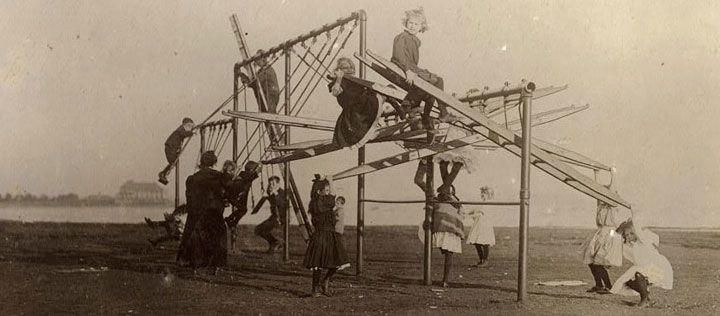The Evolution of the Community Playground

It’s a fact that playground design and engineering has come a long way. All you have to do is recall older model playground equipment and materials to have an appreciation for the safety of new structures and designs. But it is easy to assume that playgrounds were always present and part of the traditional American childhood, but the availability of playground equipment became a culture norm in communities only within the last century.
The first playgrounds actually emerged in Germany in 1885 and were called “Sand Gardens.” They provided a designated play area with soft surface for children to play in. As North America became more industrialized, more families moved from the farm to high density residential areas. For the first time in American history, some families were deprived of open fields and grassy areas for children to play. Urban planners realizing the danger and inconvenience of having children play on city streets turned to the development of designated play areas for safety. Parks became popularized after their introduction in the late 1880s, and the first playgrounds in the United States were built in Boston, Massachusetts in 1886.
How It Started: The Playground Association of America
Henry S. Curtis, the director of the Washington D.C. playground system, and Luther H. Gulick, the director of physical education in New York City, realized that importance of providing “relief” for children in dense urban cities. The collaboration of Curtis and Gulick in 1906 lead to the creation of the Playground Association of America (PAA), to champion the importance of playgrounds for the physical development of children. The formation of the association occurred on April 12, 1906 at the Washington D.C. YMCA.
The Association provided resources to communities to establish construction standards, design and layout for playgrounds, and included ideas for picnic shelters, landscape engineering, organic shading, garden areas, and swimming or splash pads. It sought to educate cities and municipalities on the importance of green space and designated play zones for children in urban centers.
In 1909 an advocate for playgrounds in Boston, Joseph Lee, was inducted into the Playground Association of America as a First Vice President. Shortly afterward, the PAA released a publication that outlined curriculum for physical education to playground directors called ‘A Normal Course in Play’ and it was provided to colleges and universities across the country. Play theory, playground planning, nature study, hygiene, games and activities were some of the topics outlined in this manual for physical education management.
The idea began to catch on quickly and the term ‘playground’ was changed in favor of ‘recreation’ to encompass all healthy aspects of indoor or outdoor play. The Playground Association of America became the National Recreation and Park Association (NRPA).
The Evolution of Formal Playgrounds and Parks
- In 1908 the first traditional playground with equipment was installed in Boston, on Tremont Street (formerly Washington Gardens). The playground was built with parallel bars, a vaulting horse and some additional gymnastic equipment in a 30 foot square outdoor space.
- In the 1950’s the first novelty and imaginative playgrounds began to surface first in urban cities where funding was available for parks and recreation development. Parks remained an ‘urban’ phenomenon for a period of time and were not deemed necessary in smaller towns or farming communities where ample space for outdoor play was available.
- In 1974 the first ‘adventure playground’ was built in Huntington Beach, California. This playground was still in operation in 2012.
Since then, playground equipment has evolved in terms of design and ADA accessibility for children with special mobility needs, allowing for inclusive outdoor play. The technology and production methods for playground equipment have advanced to provide safer, more durable structures that are both physically engaging and beneficial to the cognitive development of children.
Today there is a renaissance and a new understanding of the importance of play for the health, social and emotional wellbeing of children, and an awareness of the need for more play time and playground structures that support healthy development for children. Here at All People Can Play, we've come to benefit from this evolution of playgrounds and the cummulative effect of knowledge gained from the study of how children play. Our commercial playground structures engage children both physically and mentally, and allow them to explore socially or independently.


